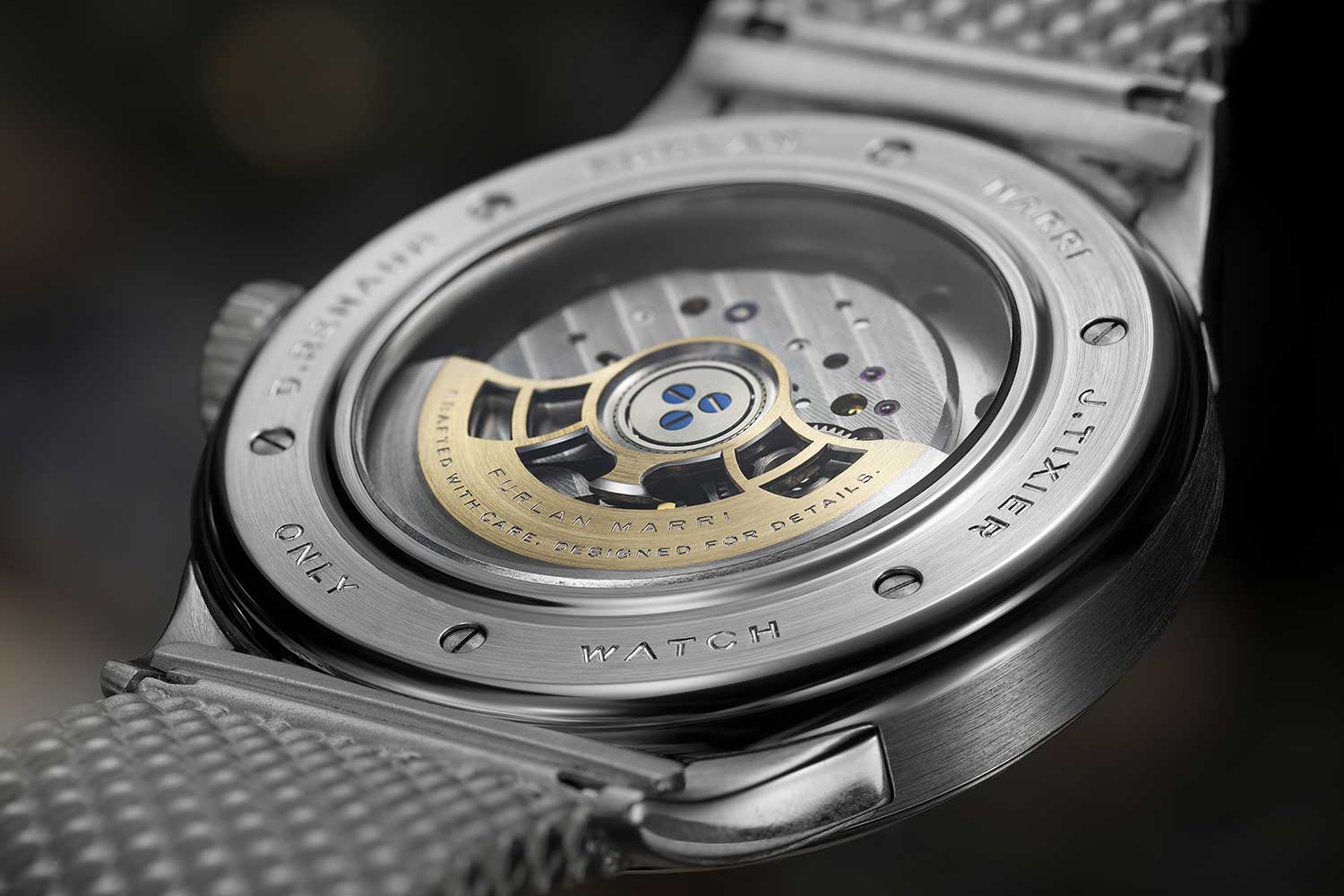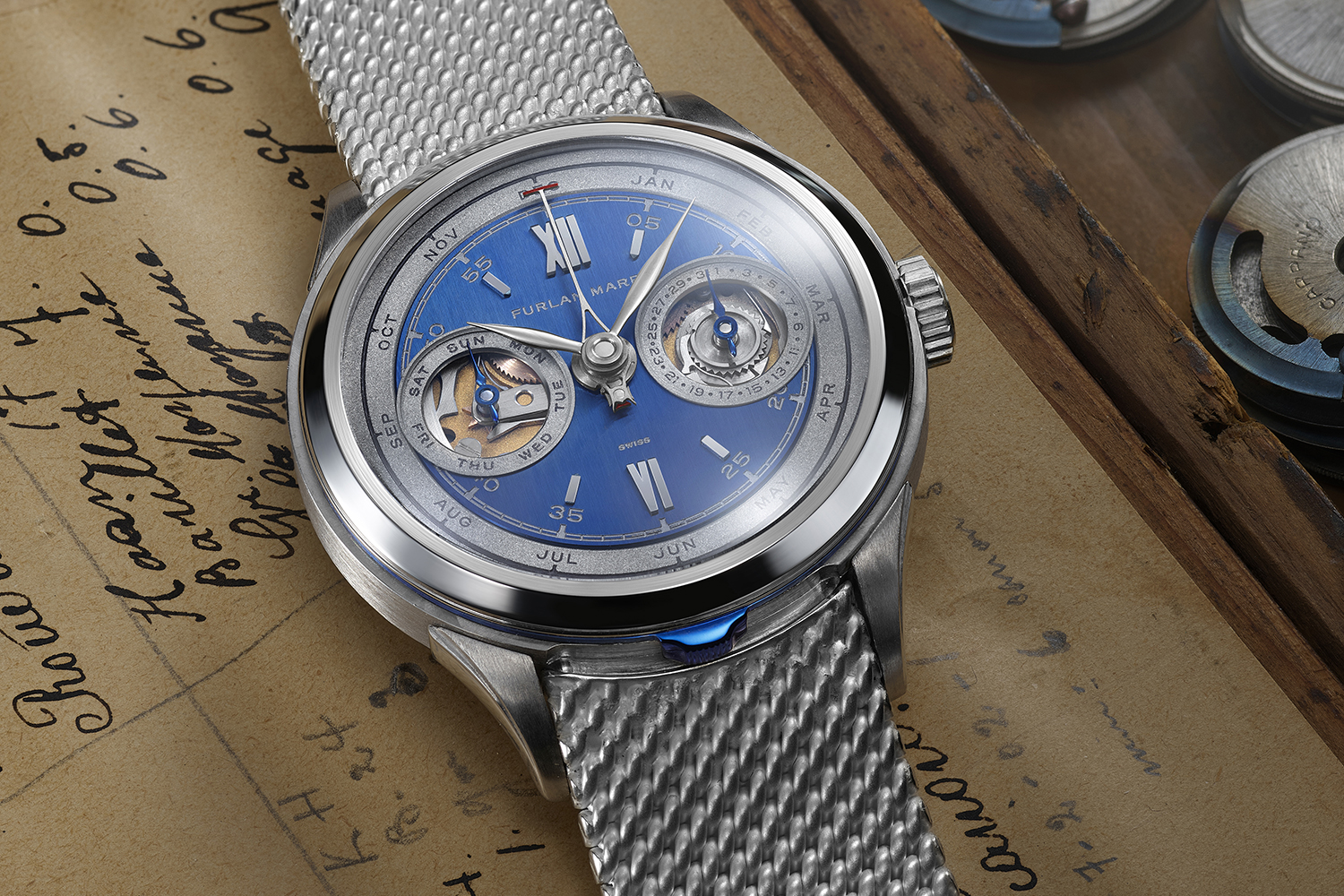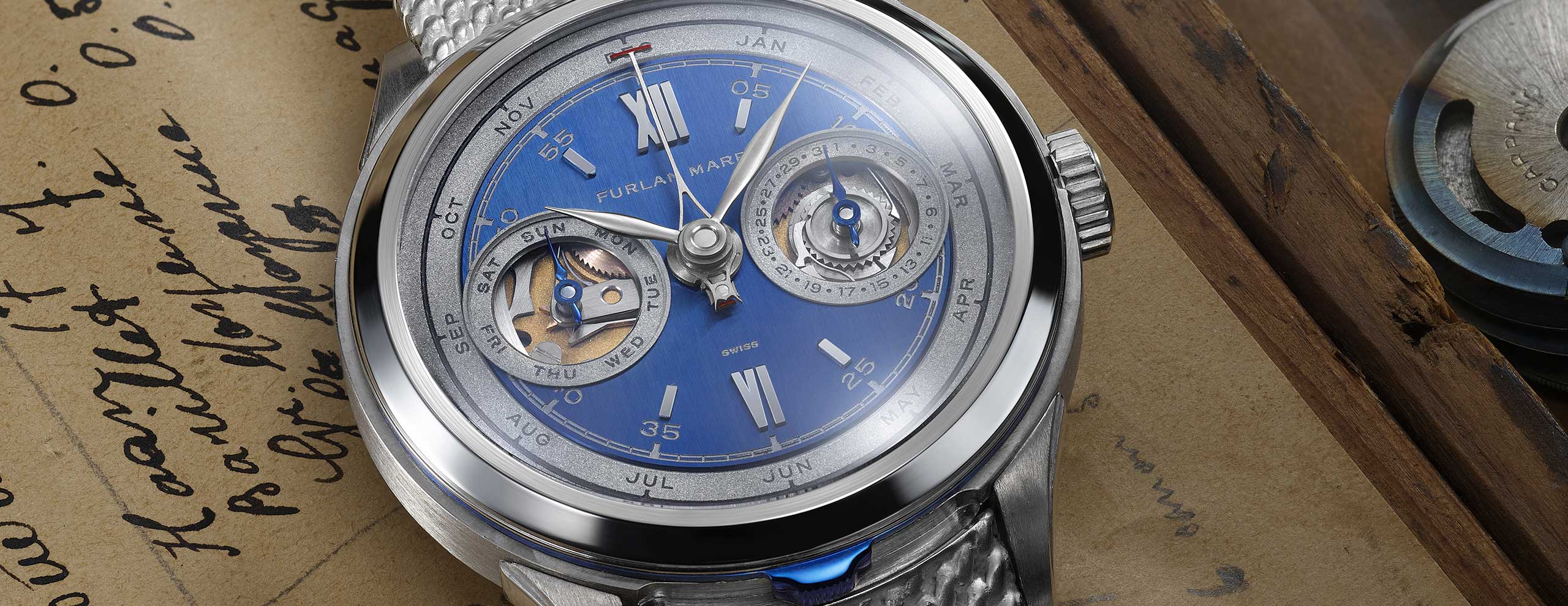Astonishing solutions to perpetual timekeeping at an astonishing price.
One of the biggest highlights for Only Watch 2023 is an unassuming watch that bears the name Furlan Marri, a brand best known for creating refined but accessibly priced, vintage-inspired watches. At a cursory glance, there is virtually nothing that suggests it is anything more than a calendar watch that displays the day and date on two subdials with the month indicated on the periphery by a central hand. It is only upon a closer inspection that you see a tiny Maltese cross pivotably affixed to a smaller central hand, which indicates that it serves as a leap-year indicator, making the watch a perpetual calendar.
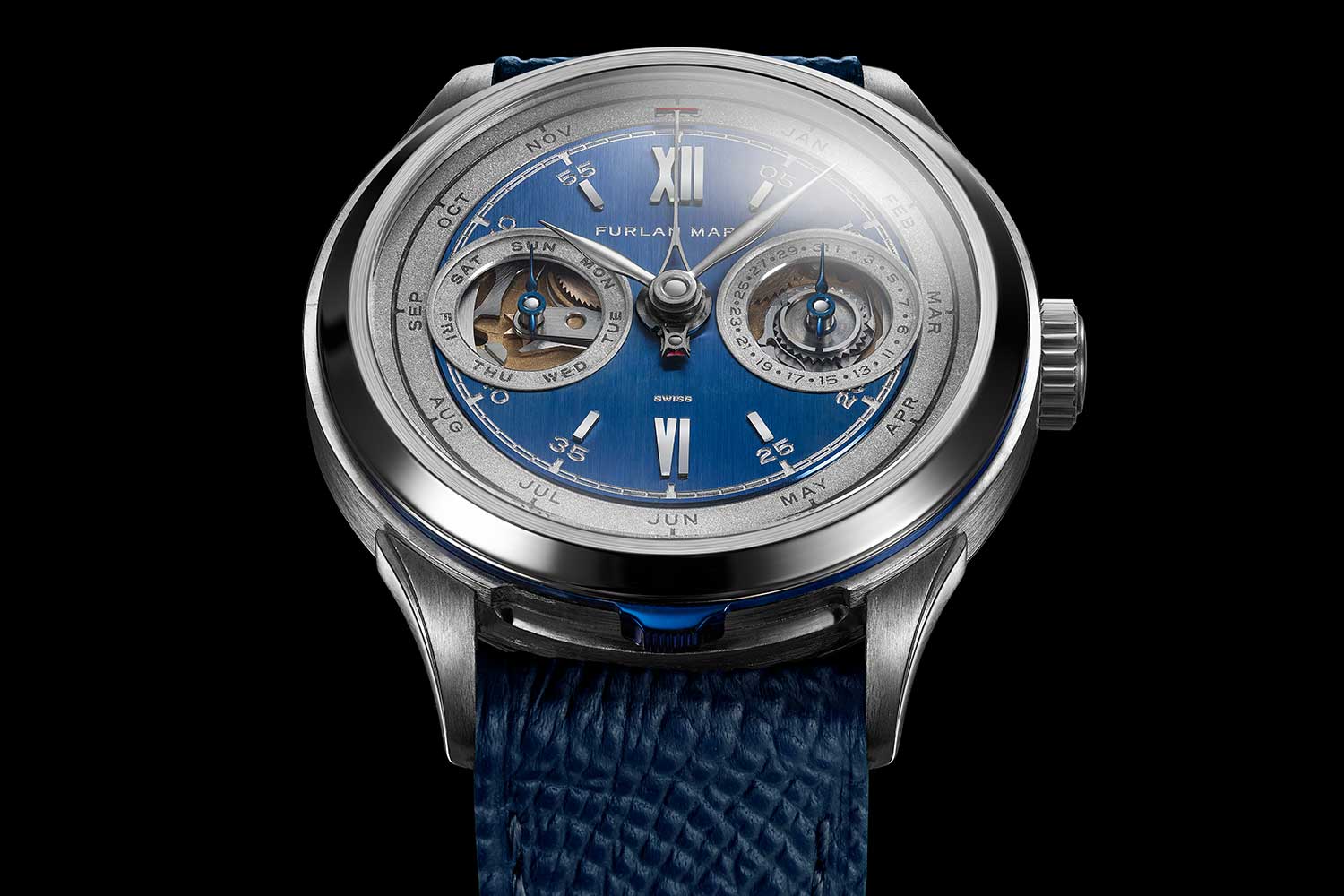
Pièce Unique Secular Perpetual Calendar by Furlan Marri x Dominique Renaud x Julien Tixier for Only Watch 2023
However, it will require more than an average human lifetime to observe that this Maltese cross will accurately mark 2100 as a common year, not a leap year. This is because it is not just a perpetual calendar, but a secular perpetual calendar. In other words, it belies a masterpiece of a movement.
As a recap, the Gregorian calendar dictates that a year has an extra day at the end of February if it is divisible by four. However, if the year is also divisible by 100, it becomes a common year with only 365 days. But if the year is also divisible by 400, then it becomes a leap year again. By design, a regular perpetual calendar, which only encodes a four-year cycle, will interpret the years 2100, 2200 and 2300 as leap years when in fact they are common years. As such, a manual adjustment by one day is required on March 1 of these years.
A secular calendar, on the other hand, will account for all the anomalies of the Gregorian calendar, encoding a 400-year cycle in its gear train — that is, it takes care of non-leap years in three consecutive centuries, as well as the leap year that occurs in the fourth century. Put simply, as long as the watch is consistently wound, it will stay synchronized with the Gregorian calendar and will not require any intervention.
The Ultimate Calendar Complication
It is worth noting that the Gregorian calendar itself is not perfect; it gradually accumulates an error of around one day every 3,030 years. This discrepancy arises from the difference between the calendar year, which consists of 365.2425 days, and the actual solar year, which is approximately 365.2422 days long. Consequently, this implies that the calendar would need to be corrected by one day every few millennia. However, the secular perpetual calendar does not require any adjustments to align with the Gregorian calendar — ever.
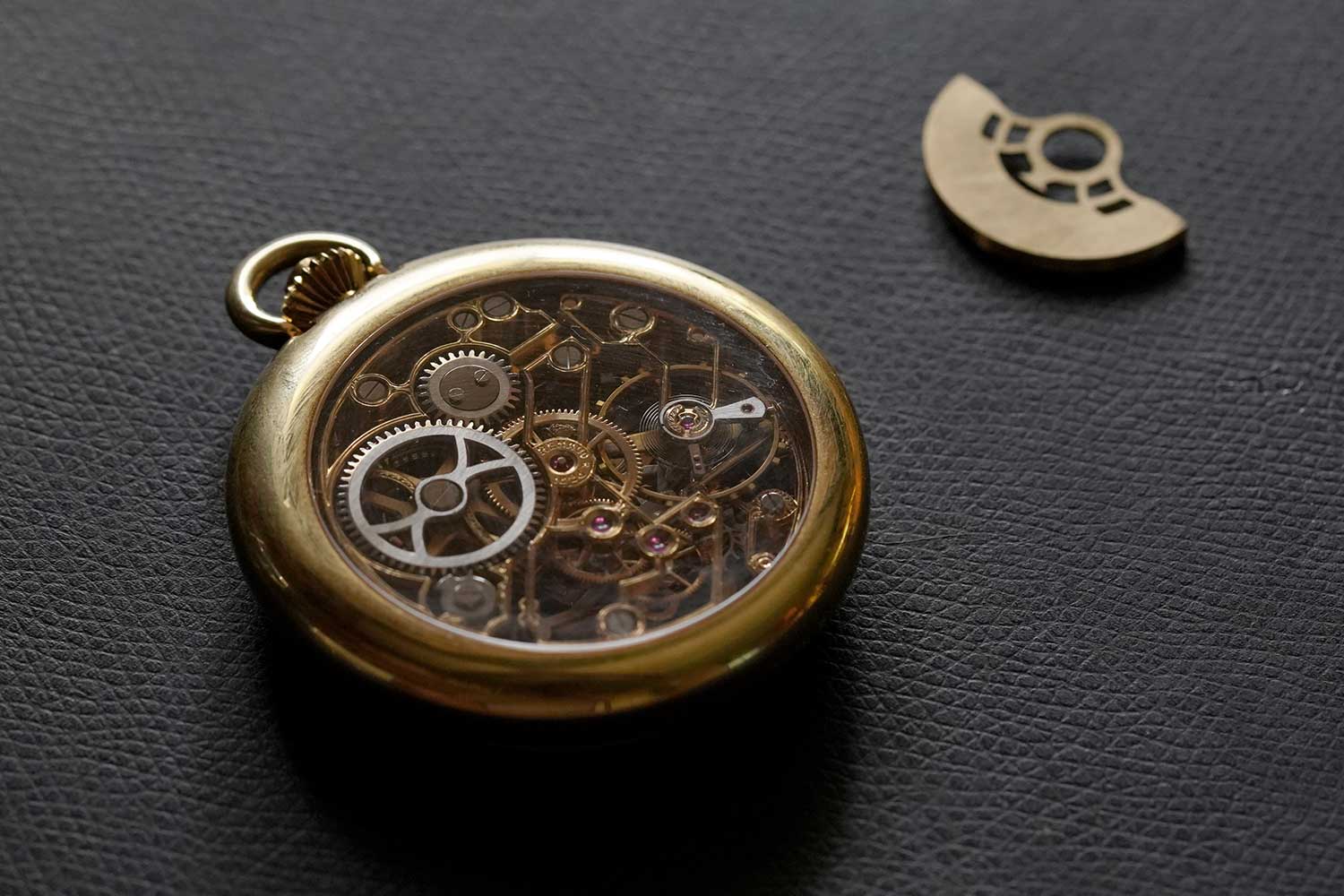
First perpetual calendar from Dominique Renaud
Secular perpetual calendars are exceptionally rare in watchmaking due to the hurdle of having to override the month program wheel (48-month or 12-month cam) with notches of varying depths that correspond to the length of each month in a perpetual calendar every 100 years. Consequently, they are frequently subject to patent protection or described in a broader sense, with references to their superior capabilities while avoiding disclosure of the precise methods employed. An upside to this is that unlike a standard perpetual calendar, no two secular perpetual calendar mechanisms are alike with each harboring a plethora of unusual and ingenious solutions of its own.
Although already a rarity, the Furlan Marri’s secular perpetual calendar differs drastically from the few known examples both in terms of its fundamental construction as well as its ease of use. It was the outcome of a collaboration between Furlan Marri, Dominique Renaud, renowned as the co-founder of Renaud & Papi, and Julien Tixier, a talented 30-year-old independent watchmaker.

Andrea Furlan and Al Marri
Andrea Furlan had previously been involved in the design of Dominique Renaud’s DR01, while Julien Tixier and Dominique Renaud crossed paths in 2016 during Dominique’s lectures on his DR01 project. Julien attended these lectures regularly, displaying a keen interest in Dominique’s research. Their friendship eventually led to the “Tempus Fugit” project for Only Watch 2022, an extraordinary gear-based secular perpetual calendar with a personalized countdown function based on one’s probable life expectancy.
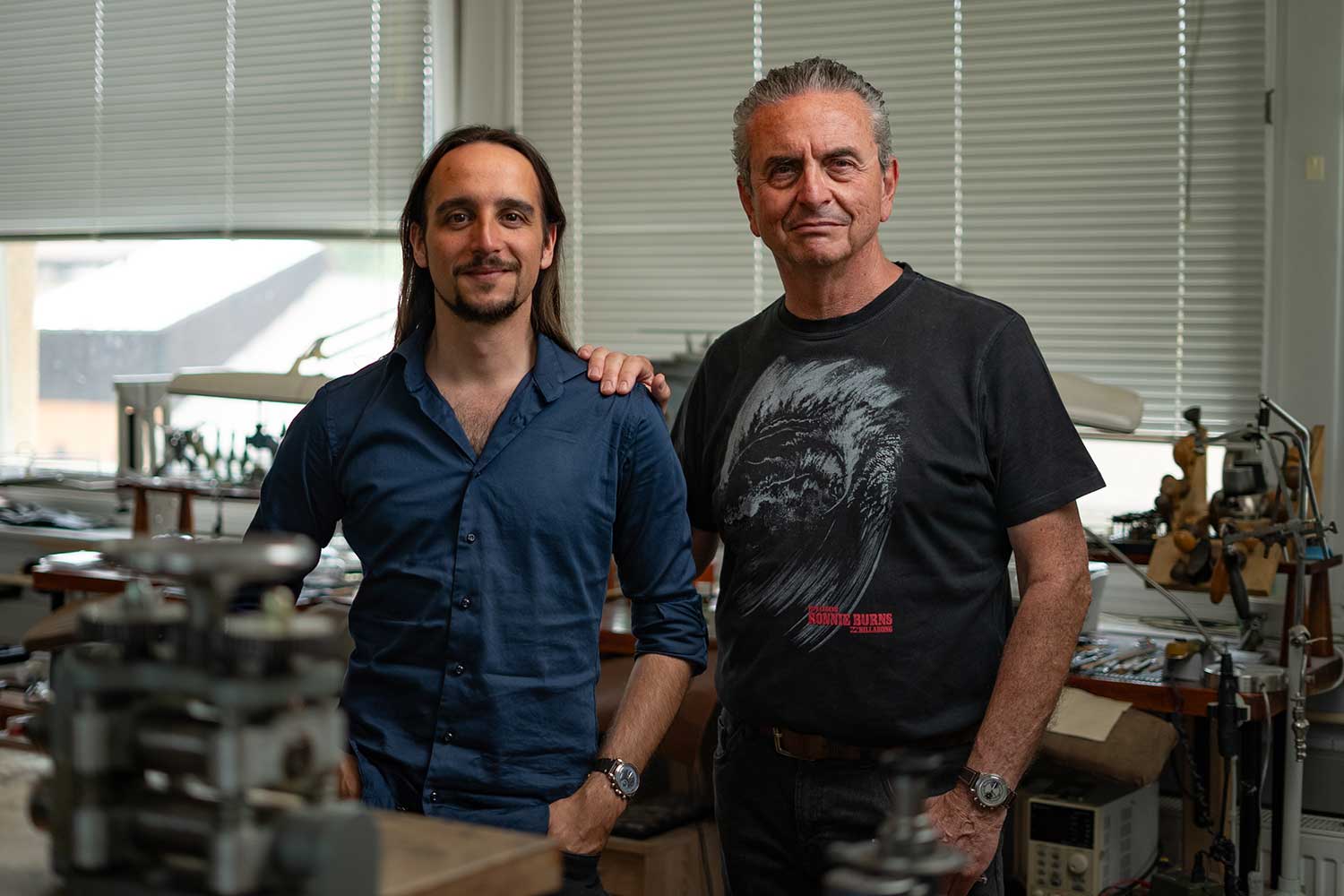
Julien Tixier and Dominique Renaud
The Tempus Fugit was conceived by Dominique Renaud and was made by Julien Tixier in his workshop in the Vallée de Joux. The duo reunited this year to create the secular perpetual calendar for Furlan Marri.
While developing a secular calendar is, by any measure, a tremendous feat, the ingenuity of Furlan Marri’s Secular Perpetual Calendar also lies in its stunning simplicity. Unlike a typical perpetual calendar module that consists of over 200 components, the Furlan Marri Secular Perpetual Calendar is composed of merely 25 parts, including a secular assembly made up of only five components. To date, this is the simplest possible mechanical solution to address all the anomalies of the Gregorian calendar in a wristwatch. But as you’ll come to find, mastering simplicity involves understanding the problem and its solutions in real depth before attempting to distill them down to their most basic essence.
In short, embracing complexity is crucial in the pursuit of simplicity.
The most significant deviation from the conventional perpetual calendar design is the use of a circular peripheral rocker instead of a grand lever pivoted on axes that typically extends across the central section of the movement. This offers the advantage of having easy access to any point on the calendar plate while creating more room in the center of the movement. As with a standard perpetual calendar, this peripheral rocker is activated daily by a finger cam that is driven by a 24-hour wheel linked to the motion works.
At the end of each day, it acts on the peripheral rocker, causing it to turn in a counterclockwise direction. The rocker is equipped with a date-change pawl, the travel of which acts on the 31-tooth date star, causing it to advance by one tooth. The date star is pivotably mounted on a date snail cam with a single tooth, which drives a 48-month wheel at the end of the month.
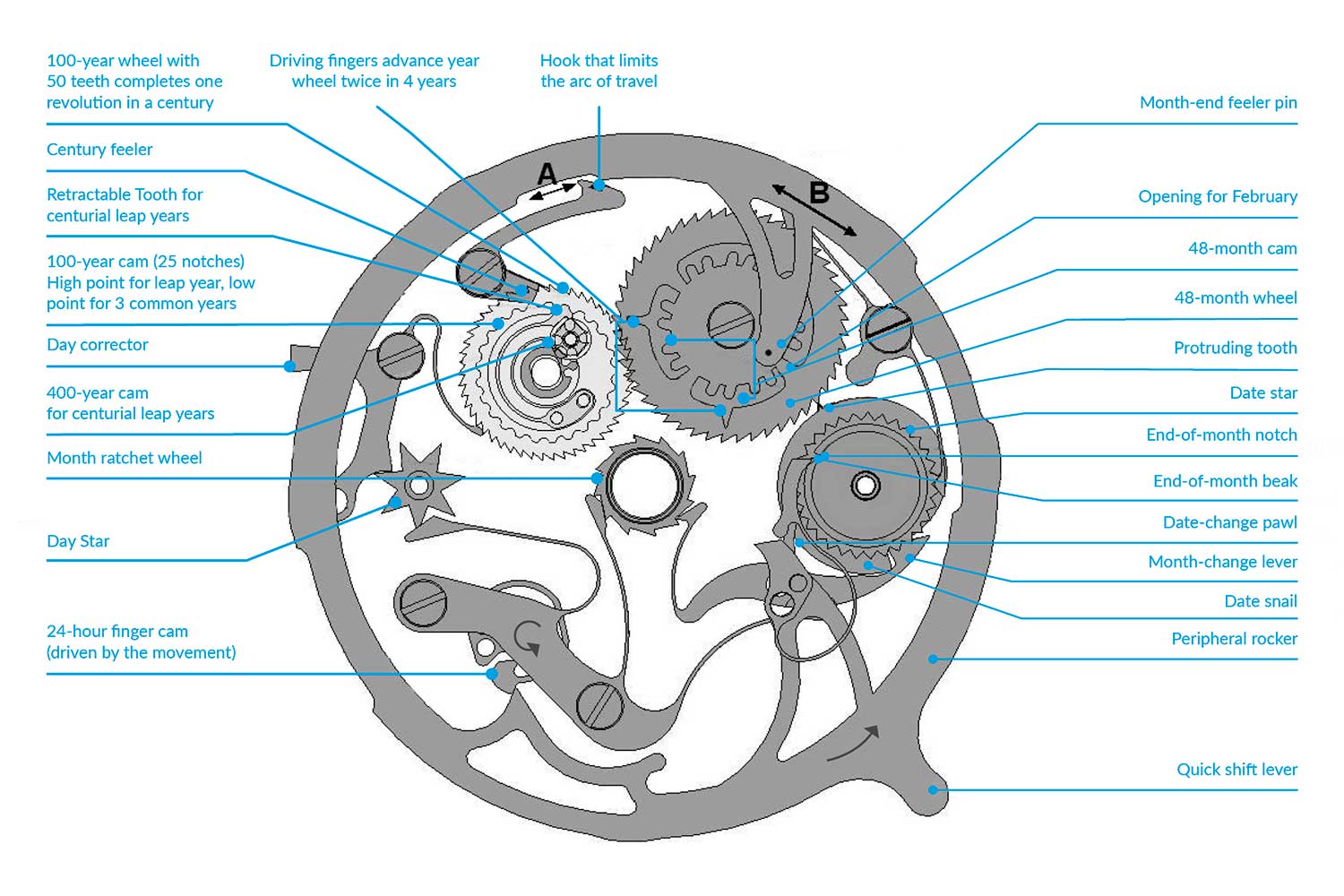
The clever and highly unusual mechanics of the secular perpetual calendar module
As mentioned earlier, the most fascinating part about secular perpetual calendars is how they negate the month program wheel, which lies at the heart of every perpetual calendar, every 100 years. Two renowned secular calendars, namely the Patek Philippe Calibre 89 and the Franck Muller Aeternitas Mega, employed distinct but traditional program wheels. The Patek Philippe Calibre 89 utilized a standard 12-month cam featuring a Maltese cross satellite to manage the month of February, while the Franck Muller Aeternitas Mega incorporated a 12-month cam that operates in conjunction with a leap-year cam. As such, the leap year is already encoded in these systems.
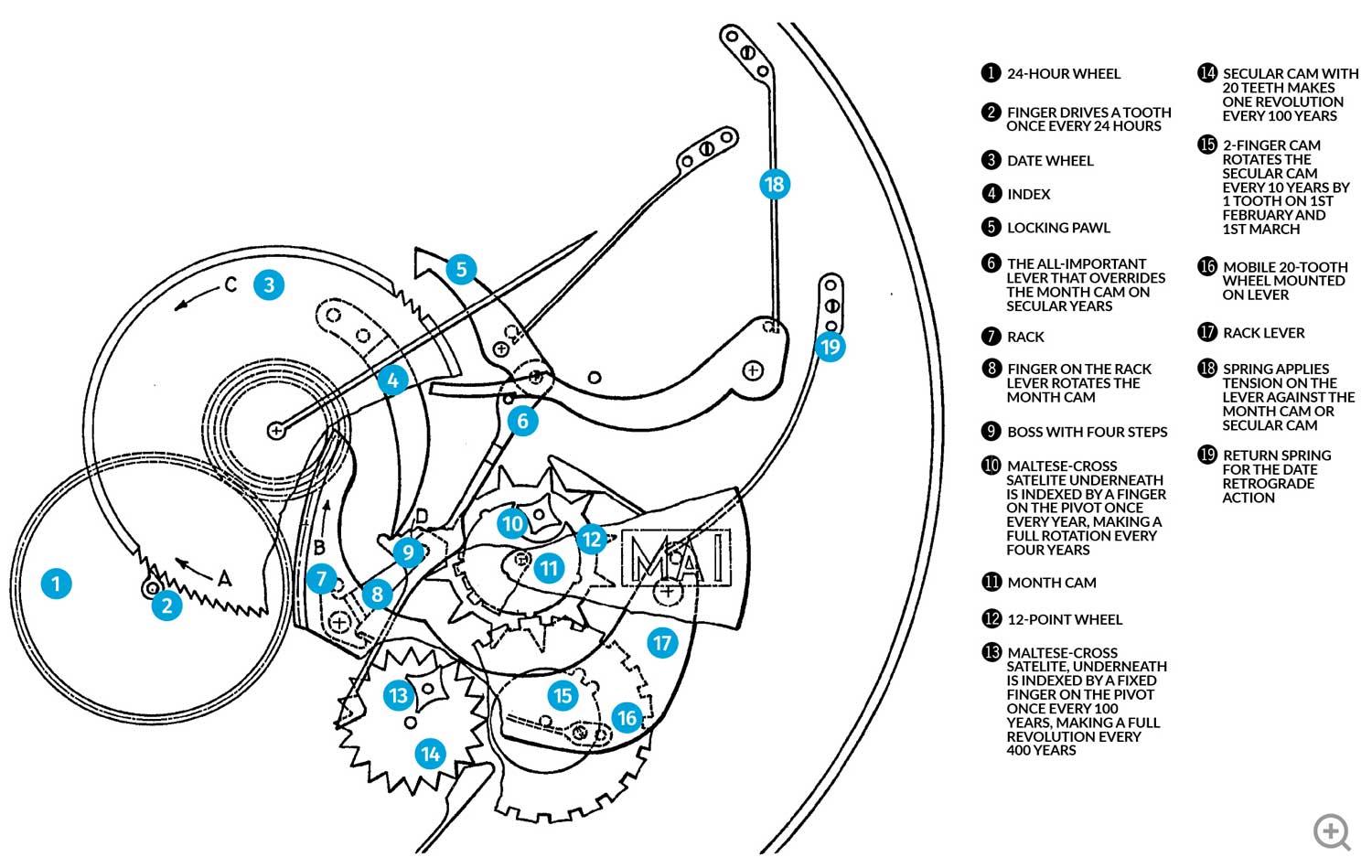
Patek Philippe’s secular calendar mechanism in the Caliber 89 from the original patent. Components No. 10 and 11 are the 12-month cam with a small four-point cam that is fixed to a Maltese cross satelite
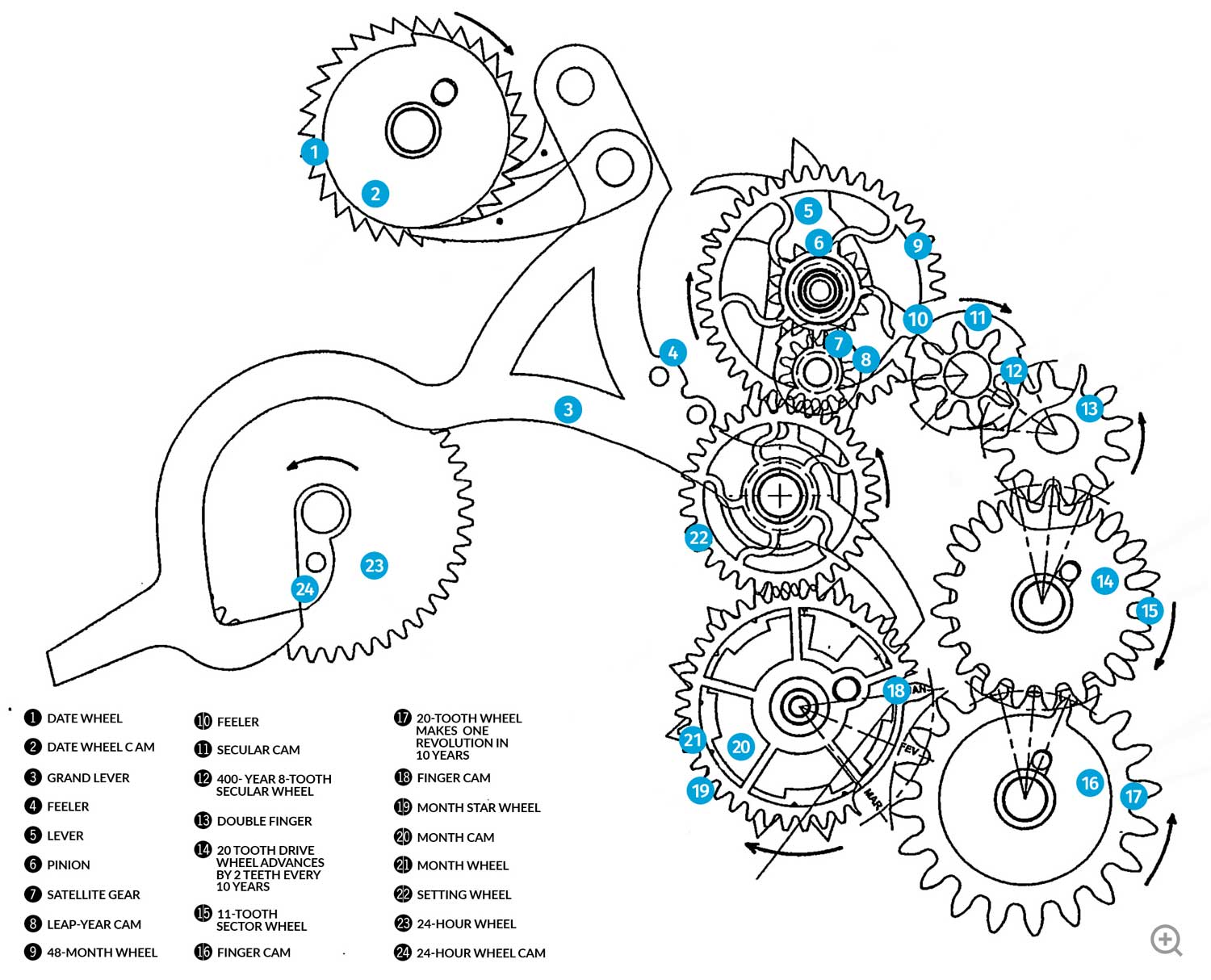
Frank Muller’s secular perpetual calendar mechanism from the original patent. Component No. 20 is the 12-month cam and No. 8 is the leap year cam
However, in the Furlan Marri Secular Perpetual Calendar, the change begins with the program wheel itself. While it uses a 48-month cam, its design deviates significantly from the norm. Traditionally, the use of a 48-month cam that performs one revolution in four years, in contrast to a 12-month cam, would mean that the leap year must be encoded in this cam. The 48-month cam in a perpetual calendar is hence always designed with notches of four different steps to correspond to the length of months — 31, 30, 29, and 28 — with the deepest representing 28 days of February, and its full diameter representing 31 days.
But in this case, the 48-month cam was designed with only two depths to encode 31- and 30-day months and is sampled by a feeler pin attached to the peripheral rocker. At the same time, the cam was designed with internal steps rather than external, with four openings for the month of February. These steps limit the travel of the peripheral rocker, enabling an end-of-month beak to engage with a latch on the 31-tooth wheel and move it to different positions when the month comes to an end. At the end of the month, the spring-powered month lever, under tension from a date snail, promptly propels the month star located in the middle, causing it to advance by one position.
Every February, however, the feeler pin passes through completely, extending the amplitude of travel of the peripheral rocker. Thus, the month program wheel is overridden every February, rather than every 100 years as in the case of the Patek Calibre 89 and the Franck Muller Aeternitas Mega.
The 48-tooth wheel on which the month cam is mounted has two driving fingers that advances a 100-year wheel by two positions every four years. This 100-year wheel has 50 teeth, thus completing a full rotation in a century. A rotatable 100-year cam with 25 notches is mounted on it. The low steps of this cam correspond to February with 28 days, while its high steps correspond to 29 days. During a 29-day February, the first driving finger advances the 100-year wheel by one position and a feeler lever bears on the high step of the cam. This feeler has a hook arm that limits the travel of the circular peripheral rocker.
Once February 29 has passed, this hook arm drops to a low level and remains inactive for the next three common Februarys. This is because there are only two driving fingers on the 48-month wheel, and as the second driving finger advances the 100-year wheel, the feeler lever bears on the low step of the cam and remains there to account for the next three common Februarys. When the hook arm drops, the rocker travels further, catching the date snail at an earlier date and forces the date change.
Now, to account for centurial years that are not leap years, as well as the leap year in the fourth century, a Maltese cross mechanism was employed. It comprises a finger cam on the 100-year wheel arbor that gears with a wheel shaped like a Maltese cross, which has four branches and completes a full rotation every 400 years. This Maltese cross is attached to a cam with a pitch circle radius that is greater on one end. During the leap year every four centuries, the high point of the cam acts on a feeler with a retractable tooth, pushing the tooth outwards so that it comes into contact with the amplitude-limiting feeler lever, accounting for a 29-day February in the fourth century.
Its ingenious simplicity is breathtaking. Because the rocker that controls all the individual mechanisms is located on the periphery, it can also double as a corrector. Setting the date is accomplished by rotating the corrector (a blue tab positioned between the lugs) to the right, while turning it to the left corrects the days of the week. On the other hand, the hours and minutes can be adjusted in a conventional manner using the crown.
The entire secular perpetual calendar module is machined, adjusted and decorated by Julien Tixier, while the oscillating weight was cut and beveled by Dominique Renaud. The base movement is the La Joux-Perret G100, a workhorse self-winding movement with a respectable power reserve of 68 hours while maintaining a beat rate of 28,000vph.
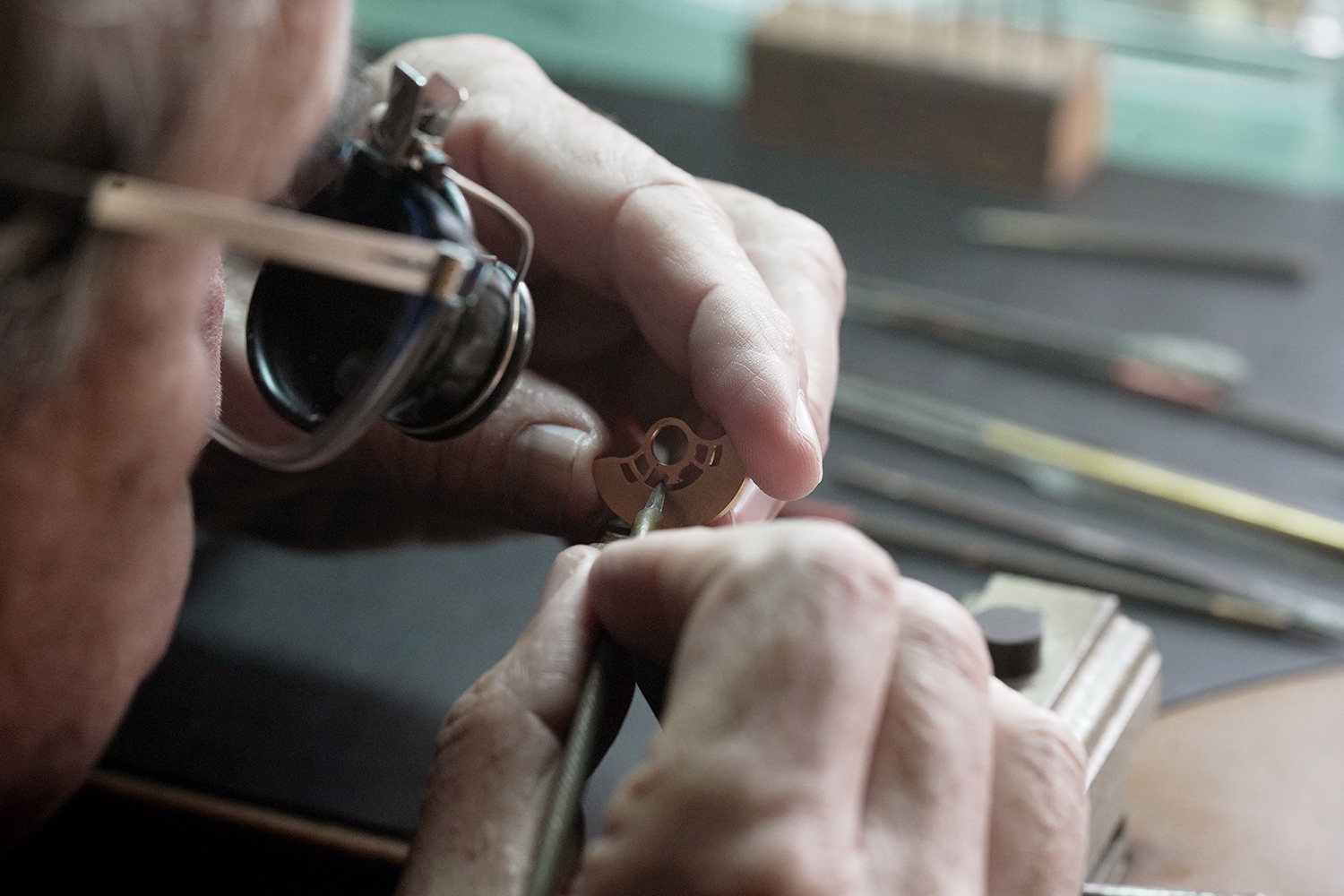
Dominique Renaud is seen working on the oscillating mass
The case is made of rhodium-plated silver, giving it a brilliant white appearance that resembles white gold and platinum while being more affordable. Its proportions are just right, with a diameter of 39mm and a thickness of 11.3mm including the crystal. The case is predominantly brushed, with a polished bezel, while the exposed corrector tab is made of anodized titanium. It is paired with a silver Milanese bracelet, giving it a dash of rakish charm, as is characteristic of Furlan Marri watches. The bracelet was handcrafted by Laurent Jolliet in Le Lignon, one of the last chain makers in Europe. The production of the coils does not involve the use of machines; instead, all the assembly and soldering processes are carried out manually, as is the shaping of the clasp.

Laurent Jolliet, the last Swiss chain maker
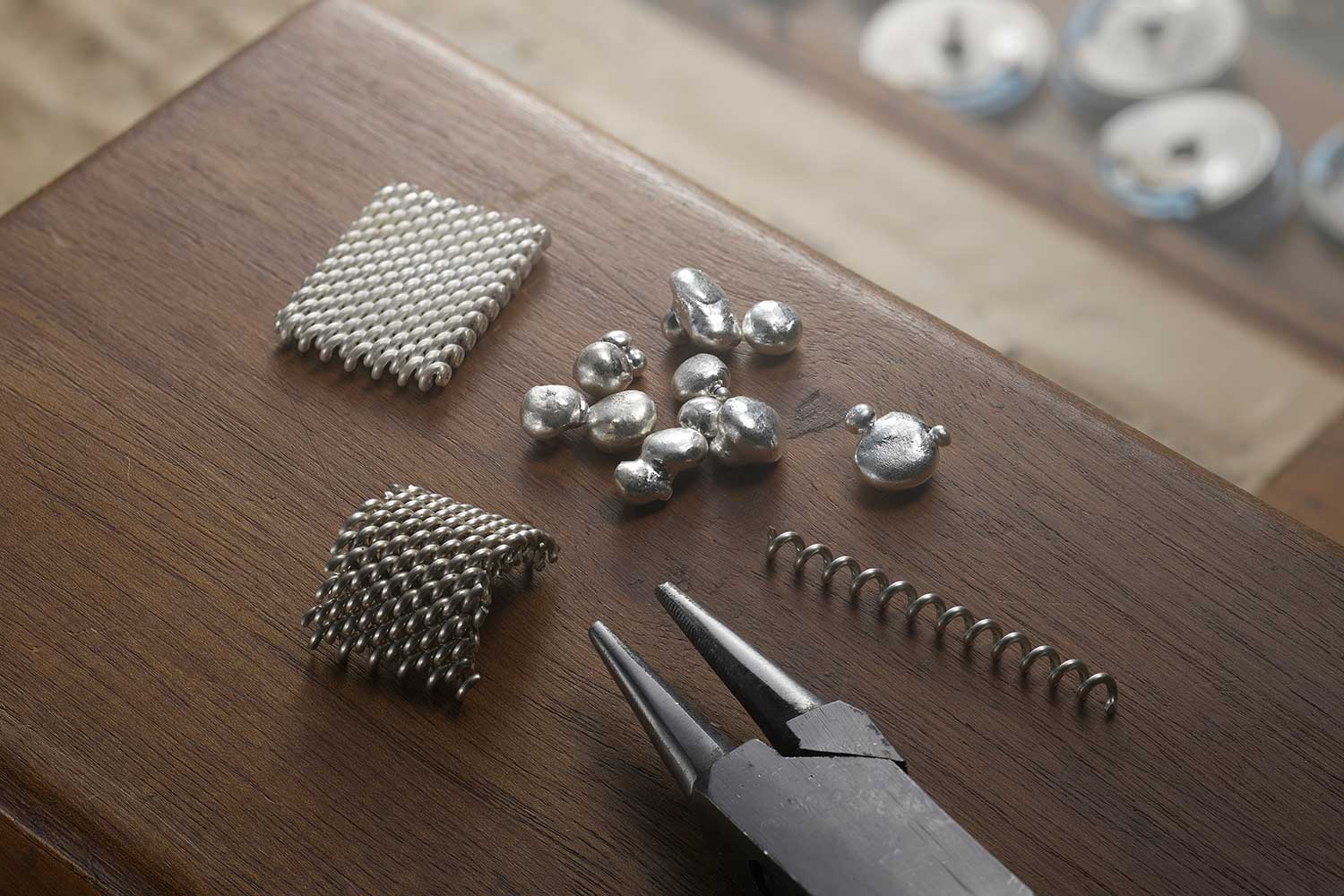
The entire process of crafting mesh using hand-wound spiral wire coils is carried out entirely by hand.
The dial is made of anodized titanium with sandblasted chapter rings for the month, day and date. It strikes an incredible balance between clarity and engaging details. The leaf-shaped hour and minute hands are crafted by hand, possessing a form and thickness that cannot be achieved with a stamping machine, as are the blued hands for the day and date displays. The counters are open-worked, revealing the most rudimentary parts of the secular perpetual calendar, namely the day and date mechanisms.
Meanwhile, the most revolutionary aspect of the perpetual calendar — the big secret involving the month and secular program wheels — remains hidden, which only adds to its remarkable stealth.
Lastly, the Secular Perpetual Calendar comes with an estimate of CHF 20,000 to CHF 30,000, which seems woefully insignificant for such phenomenal work. It is worth keeping in mind that secular perpetual calendars, being the pinnacle of perpetual calendars, are either found in grand complications or only obtainable at a prohibitively high cost. It takes a special blend of brilliance and tenacious stubbornness to undertake watchmaking of this caliber at this price. The ability to streamline a broadly unmastered complication is deeply impressive, and to understand it is to love it.
Pièce Unique Secular Perpetual Calendar by Furlan Marri x Dominique Renaud x Julien Tixier for Only Watch 2023Movement: Self-winding secular perpetual calendar module developed by Dominique Renuad and Julien Tixier on top of base caliber G100 by La-Joux-Perret; 68-hour power reserve
Functions: Hours, minutes, date, day, month, leap-year indication and secular calendar
Case: 39mm; rhodium-plated silver; hand-engraving on caseback by Coralie Mercier
Dial: Blue anodized titanium dial with hands crafted by Julien Tixier
Strap: Milanese mesh bracelet; rhodium-plated silver clasp made by Laurent Jolliet; additional calf-leather strap provided
Price: Estimate CHF 20,000–30,000








